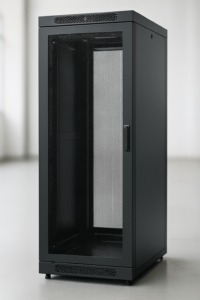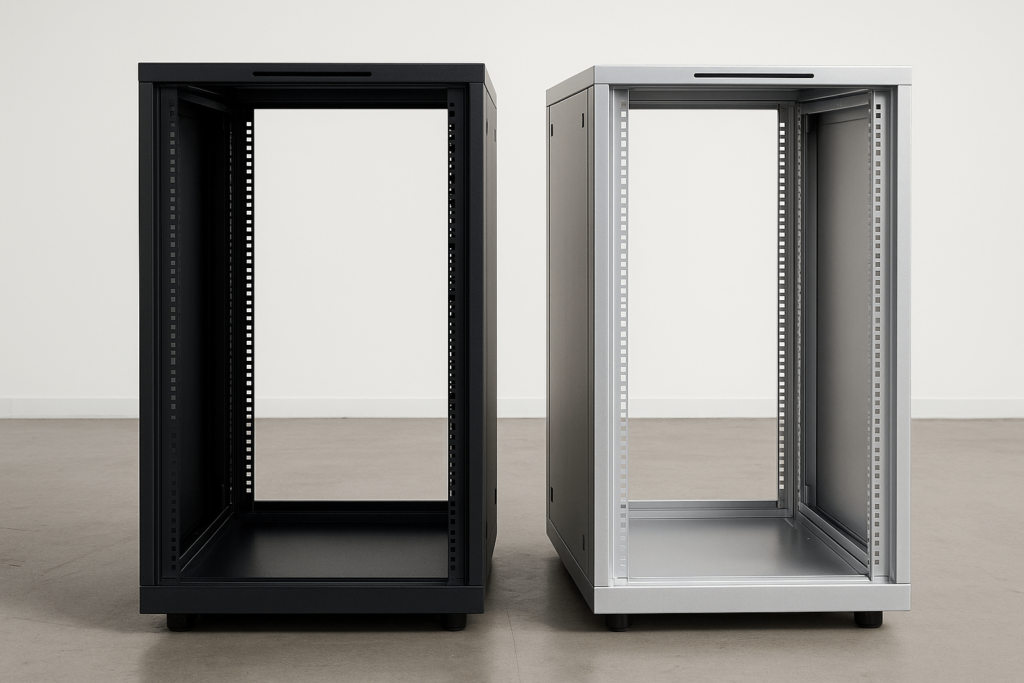Is Your Server Cabinet a Ticking Time Bomb or a Strategic Asset?
In the core of every modern media operation, the server cabinet is a mission-critical component. Too often, it’s viewed as a commodity—a simple metal box. This perspective overlooks a crucial business reality: the cabinet is a strategic asset protecting your most valuable hardware and data.
A single failure point, like overheating or a security breach, can be catastrophic. The financial cost of IT downtime is staggering, with hourly losses for many enterprises exceeding $300,000, and in some cases, reaching over $5 million.
This reality reframes the procurement decision. Investing in a high-performance media server cabinet isn’t just an operational expense; it’s a high-ROI insurance policy against financial and reputational disaster.
Why Your Media Environment Needs a “Beyond Standard” Cabinet
The high-pressure environment of media and broadcasting imposes demands that generic IT racks are not engineered to handle. The constant flow of high-bitrate video and the heat generated by high-density hardware create a perfect storm of potential failures.
Catastrophic Overheating
Broadcast and media hardware generate immense thermal loads. Standard cabinets often fail to provide the tailored airflow required, resulting in performance throttling or, worse, catastrophic hardware failure that can take a production offline instantly.
To meet the cooling expectations of overseas data center infrastructure engineers or integrators, many buyers now search for thermal management server rack or media server cabinet with airflow optimization.
The Chaos of Cable Management
A media workflow involves a dense matrix of specialized cabling. In a generic cabinet, this can quickly become a tangled mess that obstructs vital airflow, creates dangerous hot spots, and turns routine maintenance into a complex, high-risk task.
Physical Security Breaches
In shared facilities or mobile broadcast units, protecting physical assets is critical. A simple lock is insufficient to safeguard invaluable media equipment and IP from unauthorized access or theft, which can derail entire projects.
Structural Failure & Future-Proofing
The modern “rack and stack” deployment model—where cabinets are shipped fully integrated—places significant stress on a cabinet’s frame. A standard rack can bend or fail in transit, damaging critical equipment before it ever reaches deployment.
For global OEM buyers searching for metal server cabinet manufacturer, this is a pivotal factor influencing design selection.
Deconstructing the Perfect Media Server Cabinet: An Engineering Deep Dive
A high-performance media server cabinet is the result of four converging engineering disciplines. Understanding these pillars is essential for specifying a cabinet that delivers resilience, safety, and long-term operational value.
Pillar 1: The Art of Precision Thermal Management
Effective cooling hinges on the science of airflow control. The industry-standard Hot Aisle/Cold Aisle layout prevents hot exhaust air from recirculating, delivering up to 35% cooling energy savings.
To support this, quality cabinets feature perforated doors (with perforation rates of 63% or more) to ensure optimal airflow. Inside, blanking panels are essential to channel cool air through live equipment, eliminating inefficient bypass airflow.
Buyers often refer to this setup as an airflow-optimized rack enclosure, a valuable long-tail keyword for SEO targeting professionals.

Pillar 2: Material Science and Structural Engineering
The physical foundation of any cabinet is its structural frame. Its strength is defined by two key load metrics: Static Load Capacity (weight when stationary) and Dynamic Load Capacity (weight under movement). For pre-integrated deployments, dynamic capacity is paramount.
Choosing the right material is also crucial. As a metal fabrication specialist, YISHANG helps clients weigh the pros and cons between steel and aluminum:
| Feature | Steel (Cold-Rolled) | Aluminum |
|---|---|---|
| Strength/Load Capacity | Very High | Moderate to High |
| Weight | Very Heavy | Lightweight |
| Corrosion Resistance | Requires Coating | Naturally High |
| Cost (per unit of strength) | Lower | Higher |
| Durability | High resistance to dents | More prone to damage |
For steel structures, powder coating offers superior protection. This process creates a durable, scratch-resistant finish that guards against corrosion and emits negligible volatile organic compounds (VOCs), making it an environmentally responsible option.

Pillar 3: Intelligent Power & Flawless Connectivity
At the cabinet’s core is the Power Distribution Unit (PDU). Today’s PDUs span from basic metered units to advanced Switched PDUs, allowing for remote reboot and outlet-level control.
Proper cable routing is equally essential. One of the major risks is Electromagnetic Interference (EMI), where power cabling interferes with data transmission. Mitigation requires physically separating power and data cables, ideally routing them on opposite sides of the enclosure.
Searches like broadcast rack enclosure with EMI protection or server rack with isolated cable management align well with these design requirements.
Pillar 4: Security as Your Last Line of Physical Defense
Modern cabinets extend beyond keyed locks. Advanced access control systems—such as networked RFID readers and biometric scanners—enable strict user authentication and provide an audit trail of cabinet access events.
Security also includes monitoring environmental threats. Integrated sensors continuously assess conditions like temperature, humidity, and leaks, delivering alerts before minor issues escalate into costly failures.
The Strategic Crossroads: Standard Off-the-Shelf vs. Custom-Engineered (OEM) Cabinets
The procurement decision poses a strategic fork: opt for a standard off-the-shelf unit, or commission a purpose-built solution. While standard racks promise speed and convenience, they can quickly become limitations in mission-critical or highly specialized deployments.
A custom Original Equipment Manufacturer (OEM) solution—like those offered by YISHANG—gives you a performance-optimized cabinet designed around your exact needs. This often translates into a longer service life, fewer field modifications, and ultimately, lower Total Cost of Ownership (TCO).
OEM vs. ODM: A Crucial Distinction for Your Intellectual Property
For wholesale buyers launching proprietary product lines, the OEM vs. ODM distinction is vital. An ODM supplies ready-made designs under your branding—but retains design and intellectual property (IP) rights.
An OEM model flips this. You, the client, supply specifications and retain full control over the design IP. This not only protects your innovation but also ensures supply chain freedom and the ability to iterate or scale your product line at will.
International sourcing managers often search for server cabinet OEM China or custom fabricated media server cabinet—long-tail terms highly aligned with YISHANG’s services.
Your Blueprint to a Perfect Custom Cabinet: A Buyer’s Guide to the OEM Process
Partnering with an OEM is a structured engineering collaboration. A reliable OEM like YISHANG will walk you through a clear, step-by-step process from concept to finished product.
From Concept to Reality: The 5 Steps of Custom Fabrication
- Design & DFM Consultation: Begin by submitting requirements. The OEM team applies Design for Manufacturing (DFM) principles to streamline the design for cost efficiency and structural soundness.
- Precision Cutting & Forming: Material is laser cut to exact specifications, then shaped using CNC press brakes into cabinet components. Explore our CNC metal fabrication services.
- Welding & Assembly: Components are joined using precision welding techniques such as TIG or MIG. Fasteners, inserts, and structural accessories are installed during this phase. See our metal cabinet welding process.
- Finishing & Coating: The cabinet is then finished, typically with powder coating to protect steel surfaces from environmental wear and abrasion.
- Quality Assurance & Testing: Final QA involves dimensional checks, structural load tests, and functional validation to ensure adherence to all specs.
Crucial Questions to Ask Your Potential OEM Partner (A Printable Checklist)
Choosing the right OEM isn’t just about price—it’s about capability, transparency, and alignment. Key questions to ask include:
- Capabilities & Experience: What similar projects have you completed? Do you perform in-house testing for load ratings?
- Quality & Certifications: Are you certified (e.g., ISO 9001)? What QC processes are implemented at each production stage?
- Transparency & IP Protection: How do you safeguard our proprietary information and design files?
- Flexibility & Support: What are your lead times? Do you offer post-delivery engineering support?
Future-Proofing Your Investment: What’s Next for Media Server Cabinets?
The media server cabinet is transforming—from passive housing to intelligent, sensor-rich infrastructure. Future-ready buyers should look ahead to emerging trends.
The Rise of the Smart Cabinet
IoT-enabled cabinets are becoming the new norm. Real-time telemetry—tracking temperature, humidity, power draw, and access status—allows for predictive maintenance and remote diagnostics, reducing unplanned outages and service calls.
Relevant search queries include smart server cabinet with remote alerts or data center rack with sensor integration.
The Inevitable Shift to Liquid Cooling
As workloads like AI inference and real-time 8K video surge, air cooling is nearing its thermal limits. Liquid cooling, which offers 10–100x the efficiency of air, is gaining traction. Selecting a cabinet compatible with rear-door heat exchangers or direct-to-chip cooling is key to long-term infrastructure ROI.
FAQ: Media Server Cabinets
Q: What is the difference between a media server cabinet and a standard IT rack?
A: Media server cabinets are designed for higher thermal loads, denser cabling, and more advanced security/access controls—features often absent in generic IT racks.
Q: Can server cabinets be pre-configured for deployment?
A: Yes, many OEM manufacturers offer pre-integrated server cabinet solutions, tested and shipped ready for plug-and-play installation.
Q: Which materials are best for a durable server cabinet?
A: Cold-rolled steel with powder coating provides high load capacity and corrosion resistance. Aluminum is lighter but less dent-resistant.
Q: How do I choose an OEM for custom media server cabinets?
A: Prioritize experience in custom metal fabrication, in-house testing capabilities, and ISO certifications.
Q: What cooling method is best for high-density workloads?
A: Traditional air-cooled cabinets are common, but liquid-cooled server rack enclosures are gaining traction for AI and video-intensive environments.
Conclusion: Build It Right the First Time
The modern media server cabinet isn’t just a box—it’s a mission-critical asset that protects uptime, hardware, and intellectual property. Buying on price alone is short-sighted.
Understanding the engineering behind cabinet performance and the strategic benefits of OEM manufacturing helps you make a smarter investment. Choose a solution designed for resilience, tailored to your workflows, and built for future technologies.
📩 Have a spec sheet or drawing ready? Let our engineering team at YISHANG turn it into a fully fabricated, tested cabinet solution. Request a custom OEM quote now.

